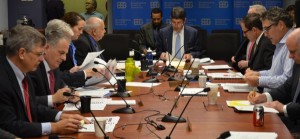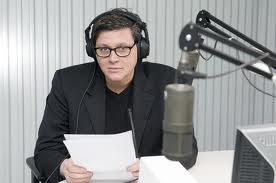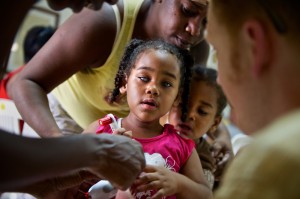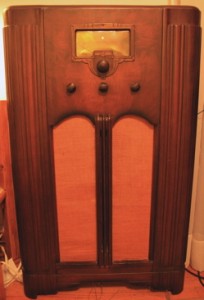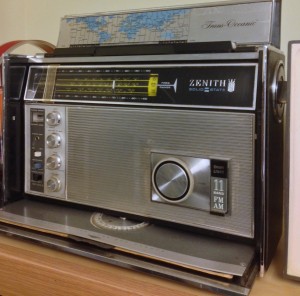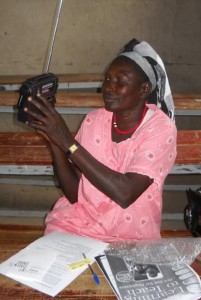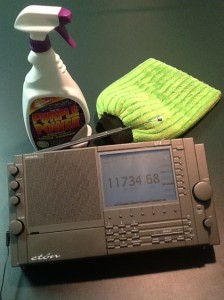“Radio Australia will preempt its regular programming beginning at 0400 UT Tuesday to provide live coverage of the running of the 2013 Melbourne Cup horse race. RA will have special programming at 0400 and 0530, before and after the race. It will join the national sports program Grandstand beginning at 0430. The Melbourne Cup is Australia’s greatest and most loved horse race and is run annually on the first Tuesday in November. It is known as “the Race that stops a Nation!”
Listeners can access the coverage via shortwave [9660, 12080, 15160, 15240, 15415, 15515, 17750, 17840, 21725; and 13630 after 0500 ] and the internet [http://www.abc.net.au/news/
sport/] and [http://www.radioaustralia. net.au].”
Category Archives: Articles
BBG changes: US shortwave broadcasts under microscope
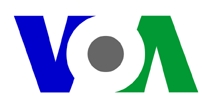 It appears the Broadcasting Board of Governors (BBG)–the bi-partisan board who oversees all international broadcasts generated by the US government–is making some changes to its structure.
It appears the Broadcasting Board of Governors (BBG)–the bi-partisan board who oversees all international broadcasts generated by the US government–is making some changes to its structure.
One of those changes will be the formation of a special committee to examine “the efficacy of shortwave radio transmissions.”
See full press release with video of the meeting below:
(Source: BBG)
WASHINGTON, DC – As a new member joined its ranks, the Broadcasting Board of Governors today announced a series of restructuring efforts to improve the way the bipartisan board operates.
“The work this agency does is vital, and we must do everything in our power to make sure we as a Board are doing the best we can – not only for our employees, but for the millions of people who depend on the news and information our networks provide,” said the Board’s chair, Jeff Shell.
Shell introduced and welcomed to the Board Kenneth Weinstein, who was confirmed by the Senate in September and sworn in on October 18. He also welcomed Assistant Secretary of State for Public Affairs Douglas Frantz, who was designated by Secretary of State John Kerry – a BBG board member – to represent him at today’s meeting.
Among the changes that the Board adopted is a simplified structure that includes an Advisory Committee and special committees focused on specific strategic issues. Two such special committees were immediately established – one dedicated to defining the responsibilities of and initiating a search for a Chief Executive Officer of U.S. international broadcasting and another to examining the efficacy of shortwave radio transmissions. The Advisory Committee is made up of Governors Shell, Armstrong, Meehan and Weinstein. Governors Shell, Armstrong, McCue, and Weinstein will serve on the Special Committee on the Creation of a CEO, while Governors Armstrong, Crocker, Meehan, and Weinstein now constitute the Special Committee on Shortwave Broadcasting.
With this meeting, the Board began using a consent agenda to adopt items of business that are non-controversial or routine. From now on, Board members will consider and vote on items of business as a group, though any member can request that an agenda item be considered separately. The use of the consent agenda, as well as a revised Board travel policy that was also adopted, were among the recommendations of the Office of Inspector General in its January 2013 inspection report.
The Board also announced the selection of Paul Kollmer-Dorsey as the agency’s General Counsel. Kollmer-Dorsey joined the BBG as Deputy General Counsel and Acting General Counsel in June 2009. Prior to joining BBG, he served as Senior Vice President, General Counsel and Corporate Secretary of Global Relief Technologies and worked for a dozen years in the international satellite communications industry. He earned his law degree from the Stanford School of Law.
And after three years with the BBG and decades of distinguished public and private sector service, International Broadcasting Bureau Director Richard Lobo announced his retirement, effective on November 30. Board members expressed their gratitude for his service and leadership during a period of budgetary challenges.
“The agency and, in fact, the country owes Dick a debt of gratitude for what he did at the IBB,” Shell said. “Dick was instrumental in developing the proposal for establishing a CEO to streamline the agency as well as leadership of the IBB during a challenging period of uncertainty and tightening budgets.”
Lobo thanked Shell and the other Board members and read from the letter he had just sent to President Barack Obama: ”The proposed implementation of the plan, which I helped formulate, to create the position of CEO and to subsequently abolish the IBB Director’s position creates the ideal time for me to step aside. After more than five decades in broadcasting, I intend to retire and return to my native state of Florida.”
Turning to the latest events affecting U.S. international media, Shell acknowledged the hard work and sacrifice required of BBG employees during the partial government shutdown that ended on Oct. 17. Despite the furloughing of approximately 40 percent of the agency’s federal workforce, programs were produced and distributed around the world uninterrupted.
In addition to the administrative challenges of operating during the shutdown, Shell took time to acknowledge how in recent months, journalists across the BBG’s broadcast regions have been harassed, threatened, and wrongly detained as a result of their work.
The simple act of reporting on public demonstrations or events has brought physical attacks on a Radio Free Europe/Radio Liberty (RFE/RL) reporter and a Voice of America (VOA) reporter in Herat province of Afghanistan, the detainment and release of correspondents for RFE/RL in Astana and in Minsk, and the arrest and beating of a VOA correspondent in Angola.
In Iran, officials have continued harassment against VOA and Radio Farda journalists and their families, and in an attempt to intimidate the press and control coverage of elections, Azerbaijan’s ruling political party has targeted RFE/RL and VOA broadcasts with complaints of illegal electioneering.
The Board also called for the immediate release of Alhurra TV reporter Bashar Fahmi as well as other journalists being held incommunicado in Syria. Fahmi has not been seen or heard from since he went missing while reporting in Aleppo, Syria in August 2012.
“The people who make up this agency are some of the most dedicated, courageous and selfless people I have ever known,” Shell concluded. “No hardship, whether it is a partial government shutdown, or unjust incarceration can stop the good work of our workforce. And for that we thank you.”
The Board paused to pay tribute to two distinguished colleagues who recently passed away – Jack Payton, an esteemed and accomplished newsman and senior editor at VOA, and Dave Strawman, recently retired manager of the BBG transmitting station in Tinang, the Philippines.
Video of October 23, 2013 BBG board meeting:
The Rebirth of The State We’re In: now a podcast via WBEZ Chicago
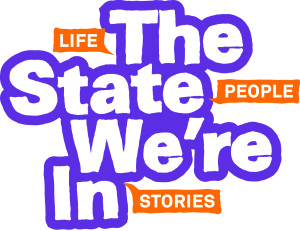 You may remember The State We’re In (TSWI) from Radio Netherlands Worldwide and how sad I was to hear TSWI was cancelled in the wake of RNW’s cuts last year.
You may remember The State We’re In (TSWI) from Radio Netherlands Worldwide and how sad I was to hear TSWI was cancelled in the wake of RNW’s cuts last year.
Well, I just heard the following brilliant news from TSWI:
“November 6th marks the rebirth of The State We’re In: The Podcast, produced every other week by Jonathan Groubert and WBEZ 91.5.”
In my opinion, The State We’re In represents some of the best radio documentary out there: TSWI has won international honors, including three New York World Medals in 2010, awards at the 2013 New York Festivals, as well as a Gabriel. Ira Glass, the talented host of Chicago Public Media’s This American Life, has praised TSWI for its “amazing editorial judgment,” and Glass rightly called TSWI host Jonathan Groubert “one of the best news interviewers on public radio today.”
Don’t believe me? Listen to some of their archived shows, like Two Enemies, One Heart. Powerful stuff.
I will be the first to subscribe to TSWI‘s podcast. As soon as the RSS feed becomes available, I will post it here.
In the meantime, check out TSWI‘s new website: http://tswi.biz
Sean crunches language numbers: Tibetan shows increase
Sean Gilbert, International Editor for the World Radio TV Handbook (WRTH), posted the following information on WRTH’s Facebook page. He has kindly given permission to share this on the SWLing Post.
“I have just been looking at the reductions in SW/MW output by international broadcasters and SW output by domestic broadcasters (where possible) in a language-by-language form. I have been keeping records of the top 19 languages used by broadcasters, since the B10 season, and I can see a reduction in output on 18 of those 19 languages. The only language to show an increase is Tibetan.
The languages that have suffered the most reduction (since the B10 season) are:
#1 German (-53%);
#2 Russian (49.6%);
#3 Farsi (-48.8%);
#4 Spanish (-45.7%);
#5 Portuguese (-43.7%);
#6 Indonesian (-36.9%);
#7 French (-32%);
#8 English (-31.2%);
#9 Arabic (-28.5%)
#10 Vietnamese (-22.5%)
This is based on the schedules we use in WRTH and, as the data is processed in the same manner each season, this does give a reasonable portrayal of the situation.
In contrast to this, Chinese is only down by -5% and Korean 1.1%, while Tibetan is UP 7.3%. The Far East languages, to be fair, tend to have a much slower decline than the more Westerly languages.
The table below shows the top languages in order of popularity (i.e. frequency of use). Chinese is the language that stands out as being the one with a noticeably slower decline. This is borne out when you tune the SW broadcast bands! I will fill in the B13 data after WRTH has been published.”
David Korchin’s photography captures ETOW radios in the hands of kids
A truly rewarding experience I am privileged to enjoy as the director of Ears To Our World is to work directly with kids and teachers in the countries where we extend our mission.
This year, photographer/SWLer/radio amateur–and good friend–David Korchin (KC2WNW) accompanied me on an ETOW distribution trip to inner Belize City. Besides grabbing a few moments to enjoy a little SWLing, we worked with ETOW partner organization, The Belize Council for the Visually Impaired, to place radios with some of the children attending their annual summer camp. This was the third year we’ve worked with the BCVI, and it’s been a very rewarding journey.
Can you imagine what impact a self-powered shortwave radio might have on a child who is visually-impaired, but whose family can’t readily afford batteries? If you can fill in the answer, you’ll know why I do this.
Today, David posted his photos from the trip, documenting these truly inspirational children. The photos are nothing short of amazing. Click here to view the photos on his website: davidkorchin.com
You might recognize the radios we’re distributing; they were generously donated by Eton Corporation and are shortwave versions of their clever little wind-up workhorse, the Rover. Eton, incidentally, is celebrating their 27th anniversary today.
And, David–many, many thanks!
Shortwave Listening (SWLing): How did you get your start?
 I love hearing stories about how shortwave radio listeners and ham radio operators got interested in the hobby. I’ll tell you about my experience, but I would enjoy hearing yours either in the comments section or by sending me an email. In the coming months, I will select stories to feature on The SWLing Post––especially if you have photos!
I love hearing stories about how shortwave radio listeners and ham radio operators got interested in the hobby. I’ll tell you about my experience, but I would enjoy hearing yours either in the comments section or by sending me an email. In the coming months, I will select stories to feature on The SWLing Post––especially if you have photos!
As I started to write a little of my personal history in radio, I felt a sense of déjà vu. That’s because in May 2011, Monitoring Times Magazine asked if I would write a piece describing how I became an SWLer and ham radio operator; of course this made for a nice segue into how I started the charity, Ears To Our World. After a little digging, I have discovered the unedited piece and added/updated where necessary.
So here’s my story–(now please share yours)!
[Update: Click here to read our growing collection.]
A Love of Listening: How I Relate to Radio
Growing up, listening…
I’ve never been a fan of television. Ironic, considering that I grew up in the seventies and eighties when most kids were glued to the tube, addicted to Nickelodeon. Perhaps one of the reasons why is that I find the visual often distracts from what I want to hear. Maybe it says something about my reluctance (or inability?) to multitask, but I’m much better at simply listening, rather than listening while also being asked to watch. I prefer to close my eyes, to just listen––and allow my mind to construct images from sound.
When people ask how I became so interested in radio, the answer comes clear: I just love to listen. My father still has, in his living room, the vintage RCA 6K3 wooden console radio which emitted, like an aging, crackly-voiced Siren with her own kind of coarse charm, the various scintillating sounds that first caught my ear and captured my young imagination.
One of my earliest memories is of my father, tuning in WWV in Fort Collins, Colorado, on the RCA to set his watch to the atomic pulse coming through the aether, a practice he followed each Sunday morning. Sometimes he would allow me to tune around afterwards––on these occasions, I would catch broadcasts out of Europe, Australia, South America, as well as places I could not readily identify.
Not long after, my great aunt unearthed in her basement a classic Zenith Transoceanic, which she offered me; I took the dusty unit into my room and promptly set up a listening post. Little did I know at the time that I was joining a fraternity of radio listeners around the world who also logged and listened to stations, as I began to do, far into the night. I often fell fast asleep listening to my Zenith; no doubt, some of those mysterious DX stations I heard over shortwave and medium-wave infiltrated my dreams with languages and cultures altogether unlike my white-bread American one.
Then when I was in my teens––again, in an ironic twist––a TV repair man who came to work on my parents’ set mentioned that he was a ham, and I was suddenly introduced to the intriguing world of ham radio. Though it took several years before I pursued my ticket, as I was busy with school, music, and other typical teen pursuits, my interest in the medium deepened.
While doing my undergraduate degree, I spent a year living and studying in France. At the time, the world wide web was still in its infancy, and my portable shortwave radio, which had helped teach me French back home, now became my English-speaking companion, bringing news from home courtesy of Voice of America. Unlike satellite television, cable TV, or an internet connection, radio was also inexpensive, vital for a poor student like me struggling to pay my own way in Europe. Through just listening, a virtual sonic flight home was free and nearly instant, arriving at the speed of light.
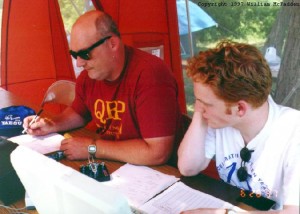
Mike Hansgen (K8RAT) teaching me the ropes at my first QRP Field Day in 1997. William McFadden was also there and was photographer for this photo. (Source: William McFadden WD8RIF)
After graduation, once more stateside, I encountered two hams who were to become lasting friends and elmers: Mike Hansgen (K8RAT) and Eric McFadden (WD8RIF). These two talented hams nourished my keen interest in the hobby, and in their company, I soon found myself in the field experiencing the scrappy fun of hands-on radio contests. I loved how my resourceful guides worked so many stations with the lowest-powered QRP equipment and only the simplest, cheapest wire antennas, and moreover, that they often derived their station power from the sun. I appreciated the remarkable skill with which they milked such modest equipment, initiating contacts all over the globe. With their steady encouragement, I finally got my ticket.
I’ve been a ham since 1997. Radio, no doubt, has influenced my decisions to travel, to live and work abroad, to pursue a graduate degree in Social Anthropology at the London School of Economics. Whatever I did, I did while listening to radio. I even changed my call not long ago to reflect my passion as a shortwave radio listener; my new handle is K4SWL.
Recently I found myself charmed and inspired by a BBC audio piece on Gerry Wells, the British radio repairman who in his eighties continues to do what he has always done, and is still sought for his skill. The story’s subject is truly enjoyable, if a bit of an anachronism: most remarkable is its relevance in the new millennium due to the simple fact that old mid-century (and earlier) radios continue to function today, and are still relied upon by listeners. As I listened to this report, I couldn’t help but wonder, as I have so often before: why does radio have such powerful nostalgic appeal? I reckon that, at least in part, it’s because radio has always been the voice of reassurance, of comfort, during darker times, reminding us that we are human, yet reminding us of our ability to survive. Radio is a friend––or, perhaps, a “great-uncle, in cords and a cardigan,” as Jeremy Paxman characterizes the BBC in his recent defense of this valuable institution in The Guardian––whose warm, familiar voice is there even when other media sources, or the internet, are down.
Shortwave, meanwhile, is much like the world’s pulse––we check in, we listen, and we confirm: all’s well, we’re still okay.
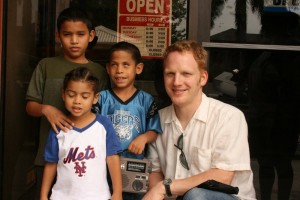
In this photo from Belize, I’m working with David (blue shirt), who is visually impaired–radio opens a world for him.
Listening as mission
One could say that listening to radio has shaped my life. I suppose that’s why radio has recently become a mission for me. Today, I’m the founder and director of Ears To Our World (ETOW), a charitable organization with a simple objective: distributing self-powered world band radios and other appropriate technologies to schools and communities in the developing world, so that kids like I once was, not to mention those who teach them, can learn about their world, too, through the simple act of listening. I want others––children and young people, especially––who lack reliable access to information, to have the world of radio within their reach.
Specifically, Ears to Our World works in rural, impoverished, and sometimes war-torn or disaster-ravaged parts of the world, places that lack reliable access to electricity (let alone the internet) and where radio is often the only link to the world outside. The heart of our mission is to allow radio to be used as a tool for education, so we give radios to teachers, who, in turn, use the radios in the classroom and at home to provide real-life, up-to-date feedback about the world around them.
Through the encouragement of our good friends at Universal Radio and the extraordinary magnanimity of Eton corporation, who donate our wind-up world band radios, in our first two years and on a budget of less than $3500, ETOW managed to distribute radios to schools and communities in nine countries on three continents––in Africa, Eastern Europe, Central and South America, and the Caribbean––as well as to both Haiti and Chile, where the dissemination of information through radio was life-saving when earthquakes struck.
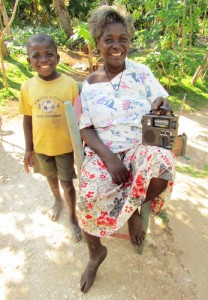
Post-earthquake, ETOW radios continue to be a vital link for those in need in Haiti. Here, Erlande, who suffered a stroke in her early 30s and can barely walk, listens to one of our self-powered Etón radios, given to her by ETOW through their partner, the Haitian Health Foundation.
We’ve done all this through partnerships––with other reputable established non-profit agencies like us––that already help struggling schools throughout the world, and who believe, as we do, in freedom of and access to information. Creating these partnerships is an important move: due to the very nature of the remote regions we serve, extending our assistance demands persistence, financial resources, and logistical support, times ten. And often a great deal of patience. Just shipping radios to other countries usually involves detailed arrangements with national and regional governmental authorities (for example, to waive duties or taxes); once the radios arrive, safely distributing them to these remote areas can also be very costly and complex. We listen attentively to our existing partner organizations, who have often laid the groundwork in these regions, and have established reliable connections with communities in them. Their need is for resources—like radios.
By listening closely to and working cooperatively with other established organizations, we find we’re able to distribute radios much more cost-effectively, too. In other words, we can operate on a shoestring budget so that donations to ETOW are used wisely and to their fullest extent. For example, because of our strong partnerships, money otherwise spent on travel can be put into shipping costs instead, thus getting more radios to more of the world with less donated funds.
So far, our scope has been limited only by our financial resources. Meanwhile, we are looking to place radios in other countries farther off the beaten path; Mongolia recently received our radios. Yet we’re not simply focusing on expansion: ETOW is establishing strong, lasting bonds with our schools and teachers so as to better serve their needs long term. We endeavor to replace their equipment and batteries as needed. We would also like to develop on-air teacher training programs; a new partnership with Oklahoma State University seeks to develop and disseminate content on important subjects, among them literacy and health education, so there is new and valuable content to listen to.
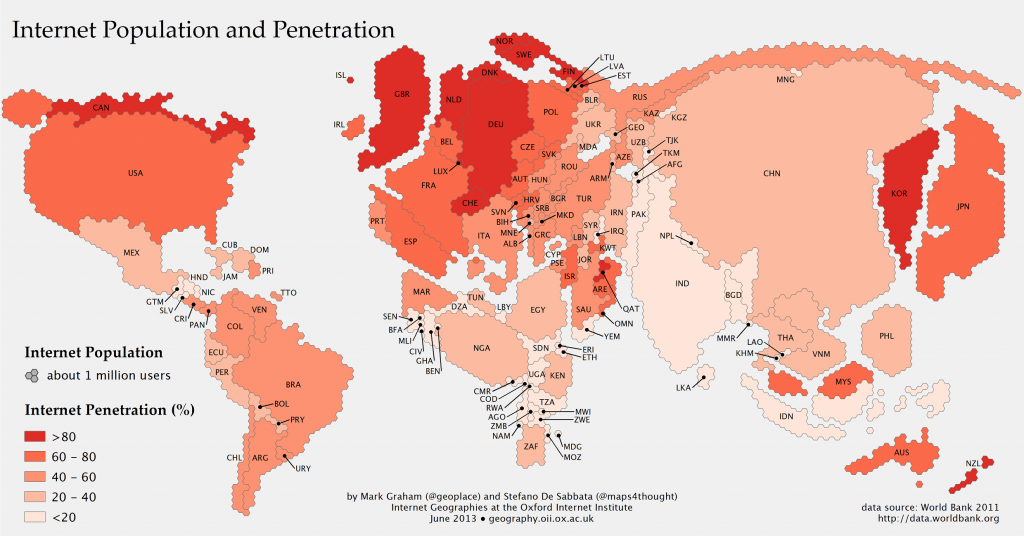
June 2013: This map shows the world adjusted for each country’s Internet population. Click to expand (Source: Information Geographies project at the Oxford Internet Institute)
MT readers [and especially SWLing Post readers] will have already guessed why we prefer radio to, say, computers, for information access. It is because much of the world does not have the communications infrastructure to support access to the world wide web and other dynamic media sources such as digital television, wireless networks or even electric power or phone. [Simply take a quick glance at the map above which shows the world adjusted for each country’s Internet population; notice how central Africa is all but missing?] Political instability, meanwhile, can undermine even the written word [for examples, check out our tag category: why shortwave radio?].
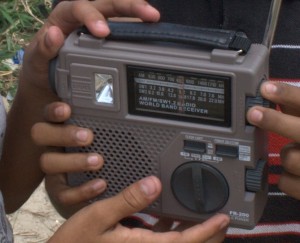 Radio, however, is simplicity itself: all one needs is a modest yet capable receiver, and one has instant––speed of light––access to local and world media. So far, every teacher we’ve worked with already knows something about radio; indeed, many of them have an intricate knowledge of broadcast schedules. But in these places it can take up to an entire week’s wages to pay for a set of batteries. Thus ETOW’s wind-up radios become vital–we effectively eliminate this cost, giving them steady access to information.
Radio, however, is simplicity itself: all one needs is a modest yet capable receiver, and one has instant––speed of light––access to local and world media. So far, every teacher we’ve worked with already knows something about radio; indeed, many of them have an intricate knowledge of broadcast schedules. But in these places it can take up to an entire week’s wages to pay for a set of batteries. Thus ETOW’s wind-up radios become vital–we effectively eliminate this cost, giving them steady access to information.
And the reports we’re hearing from the field have been overwhelmingly encouraging: Teachers in rural Mongolia, Tanzania, and Kenya are able to teach current events. Visually impaired children in rural Belize can listen to the outside world and hear music and languages they’ve never heard. Children in Haiti and families in Chile learned where to go to get food and medical care and information about loved ones affected by the quakes. A remote community in southern Sudan was able to listen to reports of their burgeoning country’s first democratic election. Being able to listen is making a difference.
Listening and learning work together
Radio captured my imagination as TV never could, it travelled with me and taught me early on that everyone has a story. Listening to radio taught me, too, that each voice is different in the consideration of what’s meaningful or newsworthy. I learned to understand––or at least appreciate––the diverse perspectives I heard in my vicarious radio journeys, and from these sprang my own opinions, hopes, beliefs. Radio became my teacher, one who gave me, in my formative years, a global perspective.
Just as radio taught me, and opened my young mind, I’m convinced that it can teach and open the minds of others. In some parts of our world, futures are still written on the airwaves. But it’s never just a one-way street–willingness to listen to those with whom we work helps us better serve them, but also to make the leaps of mind required to cross cultures, to become aware of those outside our Western sphere, to understand and grow and learn, ourselves.
Listen and learn. That’s ETOW’s tag line, but to some young people––and to me––it still means the world.
•••••••••••••••••••••••••••
Want to help us give the gift of radio? Visit ETOW online at earstoourworld.org or write us at Ears To Our World, PO Box 2, Swannanoa, NC 28778, USA.
Your personal interest, or that of your local radio club or business, could put radios in a school or village in the most remote corner of the world.
Purple Power: Another solution for sticky radios
Many thanks to Mike Nikolich (N9OVQ), who writes with another solution for sticky radios:
After the display on my Eton E-1 receiver died, the good folks at Universal Radio swapped my broken but lightly used radio for a factory reconditioned unit. Fred Osterman warned me that the plastic case was sticky and somewhat gross and he wasn’t kidding, but I was still grateful that he had a replacement radio.
After searching around the Internet (including your blog) and trying various cleaners and solutions that didn’t remove the dirt and grime from the radio (such as rubbing alcohol, Gunk and dishwasher detergent), I went to my local O’Reilly Auto Parts store and asked if they had a recommendation. Their solution was a product called Purple Power ($4.49) and a microfiber shammy mitt ($4.50). In less time than it took me to watch an episode of “Dr. Phil,” my Eton cleaned up beautifully, with no damage to the unit — it looks and feels brand new. The plastic retained that nice tacky feel without all of the stickiness that attracts gunk like dust, hair and other crud.
Purple Power is made by Aiken Chemical. You’ll want to have a clean bucket of water to remove the gunk that Purple Power removes from the plastic — it really was disgusting but I won’t hesitate to give the radio a Purple Power bath the next time it starts getting gross. And, no, I’m not affiliated with Purple Power, Eton or anyone else, including the microfiber shammy!


